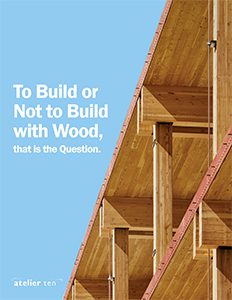
To Build, or Not to Build with Wood, that is the Question.
The use of wood in buildings is not a new phenomenon, but with increasing focus on reducing global carbon emissions, the building industry has embraced mass timber construction in recent years. The benefit of building with a renewable resource that is also beautiful has caught the imagination of the industry as well as mainstream media, resulting in a sea of conflicting information about whether using mass timber is ‘good’ or ‘bad,’ and leaving many asking whether they should build with wood or not. Decision making has become incredibly nuanced and the desire for a simplified answer to this complex question has yielded articles presenting mass timber as both the hero and villain of the construction industry. One recent article, “Wood is Not the Climate-friendly Building Material Some Claim it to Be,” published by the World Resources Institute (WRI), exemplifies this trend. Critical review and additional perspectives on this subject are essential checks and balances, but black and white conclusions do not reflect the evolving and complex nature of whether wood is a beneficial choice for a specific project. Atelier Ten has collected additional perspectives on this topic based on our experience addressing these challenging questions. The key points are summarized below or can be read in more detail in the paper linked at the bottom.
When we look at the use of mass timber in the United States, forest growth is projected to outpace mass timber demand by nearly 20%, even under the most conservative scenarios (highest demand vs. lowest forestry inventory estimates).¹ Compared to concrete and steel, which lead to the release of substantial carbon emissions prior to building occupancy, wood reduces upfront emissions by delaying most emissions until the end of life of the building.² This time delay is significant because the warming impact of greenhouse gas emissions add up over time (a phenomenon called cumulative radiative forcing), so much so that delaying carbon emissions by 50 years would lead to a 73% reduction in the total warming impact over a 100-year period.³ Additionally, the most common disposal scenario in North America is landfilling which, according to the EPA Waste Reduction Model (WARM), means that only 12% of the initial biogenic carbon sequestration is lost over a 100-year period as the mass timber slowly decays in a landfill, after which point it is considered permanently sequestered.⁴ As a final note, Churkina et. al., 2020 found that mass timber buildings can hold sequestered carbon at 3x the density of trees in a forest. which means using mass timber offers the chance to expand the sequestered carbon stock.
Atelier Ten has been working to reduce the carbon impact of buildings for many years, and in our experience, there is no silver bullet to address embodied carbon emissions. It is essential to find the balance between doing the best we can now while also identifying potential blind spots and advancing our collective understanding of global carbon emissions. It is also critical to acknowledge the tendency towards “carbon tunnel vision” while there are other important issues like the biodiversity crisis. We need strategies that can address carbon and any number of the other critical global issues. Mass timber construction is not single-handedly going to prevent climate change, but if done right, it can reduce the carbon impact of a project in the critical time period for avoiding the worst effects of global warming while also increasing biodiversity and supporting a healthy ecosystem. We still need to advocate for building reuse and material efficiency first. We also need the concrete and steel industries to improve to hit global carbon targets. While we wait for them to catch up, we believe mass timber can offer significant savings over concrete or steel, but we have found that a truly integrated design, construction, and decision-making process is essential to maximize the climate potential of using mass timber.
While the understanding of global carbon emissions continues to evolve, there are key opportunities for a project team to consider when determining if and how to use mass timber:
- Just use less. Maximize the re-use of existing buildings and design buildings to use as little new material as possible.
- Understand the boundaries and limitations of whole building life cycle assessment and how to use it as a design and decision-making tool.
- Transparency is key, both in terms of carbon emissions reporting and timber sourcing information.
- Choose the most appropriate structural system for your building typology, massing, and geological conditions (whether that’s mass timber or not).
- Prioritize sourcing from sustainably managed forests. Sourcing wood from North America is a good starting point, but timber procurement is really an evolving menu of options and the best solution for one project might not be the best for another.
- Incorporate design for deconstruction strategies to minimize waste and extend the lifespan of wood products.
- Prioritize sourcing from sustainably managed forests. Sourcing wood from North America is a good starting point but timber procurement is really an evolving menu of options and the best solution for one project might not be the best for another.
- Incorporate design for deconstruction strategies to minimize waste and extend the lifespan of wood products.
Read more about this complex topic at the link below.
